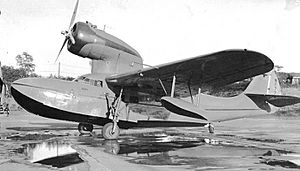Richard Archbold facts for kids
Richard Archbold (born April 9, 1907, died August 1, 1976) was an American zoologist (a scientist who studies animals) and philanthropist (someone who gives money to help others). He came from a very wealthy family, being the grandson of a rich businessman named John Dustin Archbold. Richard went to private schools and took classes at Columbia University, but he didn't finish his degree.
He used his family's money to support amazing scientific trips, especially to New Guinea, for the American Museum of Natural History. Later, he created and funded a special place for animal research in Florida. In 1929, Archbold became a member of the famous Explorers Club in New York.
Contents
Exploring Madagascar
In 1928, Richard Archbold was asked to join a big science trip to Madagascar. This trip, from 1929 to 1931, involved scientists from France, Britain, and America. It was led by Jean Théodore Delacour. Richard's job on this trip was to collect different kinds of mammals. His father, John F. Archbold, paid for the American part of the trip, but only if Richard could go along.
During this expedition, Richard met Austin L. Rand, who was the bird expert. They became good friends and worked together for many years.
Adventures in New Guinea
In the 1930s, inspired by another scientist named Ernst Mayr, Richard Archbold paid for several major science trips to New Guinea. He even led the first three of these expeditions himself. On these trips, Austin Rand was often the main animal scientist and co-leader, while Leonard Brass was the main plant scientist.
First New Guinea Trip (1933-34)
The first Archbold expedition to New Guinea happened in the southeastern part of the island. They explored areas from sea-level all the way up to cold, high mountains. For this trip, they used traditional methods like pack animals and people to carry their gear. This experience made Archbold realize how difficult it was to move supplies. It made him think about using airplanes and radios for future trips to make things easier.
Second New Guinea Trip (1936-37)
The second Archbold expedition to New Guinea took place from February 1936 to January 1937. They explored southern New Guinea, especially near Daru and along the Fly and Palmer Rivers. This time, the team used radios to communicate and even had a Fairchild 91 flying boat (an airplane that can land on water). However, a tropical storm damaged their plane in Port Moresby, which limited how much work they could do.
Third New Guinea Trip (1938-39)
The third and most exciting Archbold expedition to New Guinea happened from April 1938 to May 1939. This trip focused on the northern side of the Snow Mountains in what was then Netherlands New Guinea. They collected plants and animals from near sea-level up to over 4,000 meters high.
The expedition used a special PBY-2 Catalina flying boat called Guba II, flown by Russell R. Rogers. This plane could land on lakes and rivers, bringing supplies to the team. It also helped with looking at the land from above and taking pictures. During one of these flights, on June 23, 1938, they discovered the Baliem Valley. This valley was a big surprise because it was home to many people, the Dani people, but no one outside the area knew about it. A Dutch soldier on the plane named it Groote Vallei, or Grand Valley, and Archbold agreed to keep the name.
In August 1938, Archbold sent two teams into the Baliem Valley. Each team had Dutch soldiers, prisoners, and Dayak porters. One team started at one end of the valley, and the other started at the opposite end, hoping to meet in the middle.
First Flight Across the Indian Ocean
As the expedition was ending in 1939, Richard Archbold planned to fly back to the USA across the Pacific Ocean. But then, Captain Patrick Gordon Taylor from Australia contacted him. With World War II possibly starting soon, Australia wanted to find a way to fly from Australia to Europe over the Indian Ocean and through Africa, instead of Asia. Archbold's Guba II was the only suitable plane available quickly.
Richard agreed, and the Australian government paid for the fuel and supplies for the flight. Captain Taylor joined the crew as a navigator. The planned route across the Indian Ocean was from Port Hedland, Western Australia to the Cocos (Keeling) Islands, Diego Garcia, the Seychelles, and Mombasa, Kenya. Except for a small detour at the start due to bad weather, the flight went smoothly. In Mombasa, Taylor left the crew, and Archbold continued flying west, finally landing in New York City in July 1939.
Archbold Biological Station
When war broke out in the Pacific, the expeditions to New Guinea had to stop. In 1941, Richard Archbold created the Archbold Biological Station in Lake Placid, Florida. He lived there for the rest of his life. The land for the station was given by John A. Roebling II. After the war, there were four more Archbold-funded expeditions to New Guinea, but Richard did not go on them himself.
Images for kids



